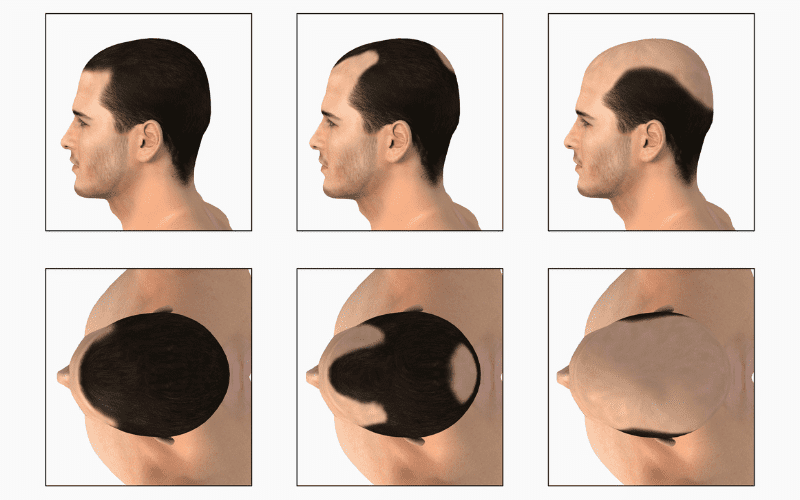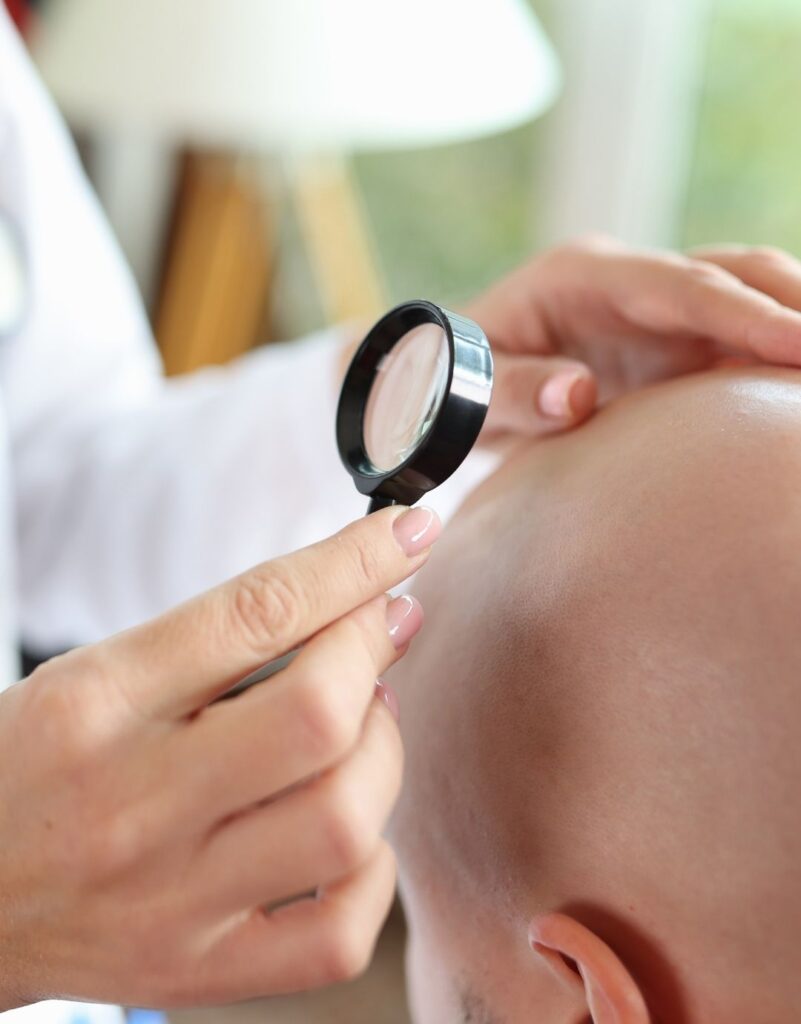Types of Hair Loss: A Comprehensive Guide
Hair loss (alopecia) is a prevalent issue affecting individuals of all ages, both men and women.
Understanding the difference between normal hair shedding and hair loss is critical in identifying possible hair loss conditions. Humans naturally lose about 50 to 100 hairs each day, a phenomenon considered standard hair shedding. However, when shedding surpasses this range, or if hair does not regrow at a similar rate, it may signify a hair loss condition.
In this detailed guide, we will explore different types of hair loss, their causes, symptoms, and treatment options. Gain a better understanding and effectively manage your hair loss condition and find solutions to address this concern.

Androgenetic Alopecia (Hereditary Hair Loss)
Androgenetic alopecia, also known as pattern baldness (male pattern baldness or female pattern baldness), is the most common type of hair loss. It is a gradual condition that develops over time, affecting both men and women.
This type of hair loss is primarily influenced by genetics and hormonal factors, which can lead to a receding hairline, thinning crown, or overall hair thinning.
It usually starts with a noticeable increase in hair shedding and progressively leads to a decrease in hair density and thickness. Symptoms may not be detected until much later in the hair loss process.
Male pattern baldness is usually inherited from either parent and tends to begin in the 20s or 30s. However, many men may experience signs of balding as early as their teenage years.
Female pattern baldness also has genetic origins, but it often occurs much later in life. It typically starts with thinning at the part line and progresses to overall hair thinning all over the scalp. It is most common in women past menopause, when hormone levels decrease significantly.
Treatment options for this type of hair loss may include topical and oral medications, as well as hair transplant procedures. However, the best results come from early diagnosis and treatment.
Telogen Effluvium (Temporary Hair Loss)
Telogen effluvium is a temporary form of hair loss caused by a disruption in the hair growth cycle, leading to an increased number of hairs entering the resting (telogen) phase. Read our post to learn more.
Sudden hair loss can be attributed to a range of factors, including physical or emotional trauma, as well as overwhelming stress.
Causes :
· Hormonal Changes : Postpartum , Menopause, Polycystic Ovary Syndrome (PCOS), Childbirth
In addition, the following factors can also contribute to telogen effluvium:
· Poor Nutrition (Vitamin or mineral deficiency)
· Endocrine disorders
· Birth control
· Acute illnesses or severe infections
Symptoms
· Sudden and diffuse hair shedding
· Hair thinning, primarily on the top of the scalp
Treatment Options
· Addressing the underlying cause (e.g., stress management, correcting nutritional deficiencies)
· Topical treatments, such as minoxidil
· Nutritional supplements containing biotin and other hair-healthy nutrients
Alopecia Areata (Autoimmune Hair Loss)
Alopecia areata is an autoimmune disorder that causes the immune system to attack hair follicles, leading to hair loss in small, round patches on the scalp, along with other parts of the body like eyelashes and eyebrows.
It is believed to be triggered by stress, genetic predisposition, and environmental factors. Alopecia areata can affect individuals of any age, it is more commonly observed in those who are younger than 20 or older than 50.
Learn more about alopecia areata.
Alopecia Barbae:
Alopecia Barbae refers to a specific form of Alopecia Areata that primarily affects the beard area in men. This condition causes hair loss in small, circular patches, which may overlap and lead to a more widespread hair loss.
Learn more about alopecia barbae.
Anagen effluvium (Chemotherapy Hair Loss)
Anagen effluvium is a type of hair loss caused by chemotherapy drugs, which target rapidly dividing cancer cells in the body. Unfortunately, these medications can also damage healthy cells like those found in the hair follicles, leading to sudden and widespread shedding of hair.
Symptoms include thinning and shedding of the scalp and body hair, which may range from mild to severe depending on the dose of chemotherapy drugs used.
Treatment for this type of hair loss usually does not involve medication, as it is often reversed once chemotherapy treatment ends.

Tinea Capitis (Fungal Infections)
Tinea capitis is a fungal infection (also known as ringworm or herpes tonsurans infection) that affects the scalp, leading to patchy or circular bald spots. It usually occurs in children and is caused by fungi known as dermatophytes, which spread through contact with infected objects or people.
If not treated, this condition can lead to severe and permanent hair loss. It is treated with antifungal medications applied directly to the scalp or taken orally.
Symptoms include redness, itching, and hair loss on the affected areas.
Treatment consists of antifungal medications, such as topical creams and oral pills. In addition, anti-inflammatory medications may be prescribed to reduce inflammation and itching on the scalp.
Trichotillomania (Hair Pulling Disorder)
Trichotillomania is a psychological disorder in which a person cannot resist the urge to pull out their own hair, leading to patchy or circular bald spots on the scalp.
It is thought to be caused by a combination of genetic and environmental factors, as well as psychological stressors. Symptoms include an overwhelming urge to pull one’s hair and noticeable patches of missing hair on the head or body.
Traction Alopecia (Hair Loss Due to Tension)
Traction alopecia is a type of hair loss caused by constant tension or pulling on the hair, often due to tight hairstyles or hair extensions.
Causes
· Tight hairstyles (e.g., ponytails, braids, extensions)
· Excessive use of hair styling tools
Symptoms
· Gradual hair loss along the hairline or at the site of tension
· Redness, itching, or inflammation of the scalp
Treatment Options
· Avoiding tight hairstyles and allowing the hair to rest
· Topical treatments, such as minoxidil
· Hair transplantation surgery (in severe cases)
What are the treatment options for hair loss?
The treatment options for hair loss will vary depending on the type and cause.
For male pattern baldness, treatment may include topical medications such as minoxidil or finasteride, oral medications and even hair transplants. For female pattern baldness, similar treatments are available including minoxidil and other topical treatments.
For temporary hair loss, treatments may include stress management techniques, nutritional supplements, and topical medications.
Alopecia areata is usually treated with topical medications such as corticosteroids. In addition, addressing the underlying psychological issues may also help reduce hair shedding.
There are more treatments like laser therapy, PRP (Platelet Rich Plasma) therapy and stem cell therapy available for hair loss treatment.
Diagnosis of Hair Loss
Diagnosis of hair loss involves a comprehensive examination and evaluation by a healthcare professional.
The process usually starts with a detailed medical history, including questions about current or previous medications, lifestyle, diet, stress levels, and family history of hair loss.
In physical examination of the scalp, doctor will look for signs of inflammation, redness, scaling, or any other abnormalities.
In some cases, a hair pull test is conducted to determine the stage of the shedding process. The doctor gently pulls a small number of hairs (about 100), usually at the end of the scalp, to see how many come out. If more than 3-4 hair strands are dislodged, it indicates active hair shedding.
A scalp biopsy may be necessary if the cause of hair loss is still unclear or if a systemic disease is suspected.
Blood tests might be conducted to check for certain medical conditions often associated with hair loss, such as thyroid disorders or autoimmune diseases. Furthermore, nutritional deficiencies, which can also lead to hair loss, can be identified via blood tests.
When to see a Doctor about Hair Loss?
It is important to seek medical advice if you notice sudden, patchy, or widespread hair loss. A doctor can examine the affected area and help determine the cause of your hair loss.
The earlier hair loss is detected and treated, the more likely it is that any treatments will be successful.
Common Misconceptions and Facts about Hair Loss
There are several misconceptions about hair loss that can lead people to make the wrong decisions when it comes to treating and preventing this condition.
1. Hair loss only happens to men, when in fact women can also experience hair loss or thinning of their hair.
2. Another misconception is that all baldness or thinning patches are caused by genetics, when in fact environmental factors can also play a role.
3. It is often thought that hair loss is unavoidable and cannot be stopped, when in fact there are many treatments available to help restore hair growth.
4. People may believe that wearing a wig or toupee can help prevent hair loss, however this is not the case as these will only cover up any existing bald patches and will not address the root cause of
5. Shampooing your hair too often causes hair loss, or that it is impossible to regrow lost hair. Neither of these are true, as the former has no scientific evidence to support it and the latter can be treated with a variety of treatments.
Last Words from the More Clinics
Hair loss is a common condition that can affect anyone, regardless of age or gender. It can be triggered by numerous factors, ranging from genetics to lifestyle choices, stress, or underlying medical conditions.
Many misconceptions exist about hair loss, leading to misplaced fear and unnecessary panic. Fortunately, numerous treatment options are available that can help manage and even reverse this condition.
GET A FREE CONSULTATION!
Let’s Start Planning Your Treatment %100 Guarantee Results.
Medically Reviewed by Dr. Seda Erdoğan who specialized on Hair Transplants, Dermatology







